Metropolitan Ear Nose & Throat Hospital
Marloes Road, Kensington, W8 5LQ
Medical dates:
Medical character:
1838 - 1977
Specialist
In 1838 the otologist Dr. James Yearsley (1805-1869) founded the Ear Infirmary and Orthophonic Institution in Sackville Street, Piccadilly. Ostensibly for diseases of the ear, those of the throat and nose were soon also treated. It was renamed the Metropolitan Ear Nose and Throat Hospital - the first hospital of its kind in the world. Dr. Yearsley, the first surgeon to specialise in these disorders, did much to improve the status of aural surgery, demonstrating how the ear had an influence on the nose and throat.
In 1846 Dr. Yearsley became physician to the Royal Society of Musicians. In the same year, with two colleagues - Dr. Tyler Smith and Dr. Forbes Benignus Winslow - he founded the Medical Directory, in which all the names of recognised medical practitioners were recorded (prior to the this time, the public was not protected against unqualified people also practicing medicine).
In 1875 the Hospital moved to 25 Howland Street and, in 1893, to 64 Grafton Street, still treating out-patients only.
In 1912 it moved again, this time to 2 Fitzroy Square (once home of the Oxygen Hospital), where it had 20 beds. The Hospital was well-regarded; the King would send game, while the proprietor of the Daily Telegraph donated free copies of the newspaper.
At the beginning of WW1 in 1914 an X-ray machine was installed and the Hospital arranged with the Naval and Military authorities to treat servicemen suffering from "gunshot injuries of the face and throat, injuries and disorders of the ears caused by explosions of mines, gun-firing and microbic infection inevitable in trench warfare waged in highly cultivated soil". From 1914 until 1919 the Hospital was designated a Sectional Special Hospital of the Queen Alexandra Military Hospital.
By 1916 one ward (Crawford Ward) had been made available solely for servicemen, while the use of the front room on the first floor of No. 1, Fitzroy Square was placed at the disposal of the Hospital by its owner, free of charge, for the duration of the war, for male civilian patients. At this time the cost per week of each in-patient was £2 0s 5d (£2.02), rising to £2 9s 11d (£2.50) in 1917.
At the end of WW1 in 1918 the Hospital had 28 beds, and the cost of each in-patient per week was £3 4s 4d (£3.22). By 1919, when the Hospital had 22 beds, this cost had risen to a staggering £8 13s 5d (£8.67) per week. However, by the following year, the cost had reduced to a more reasonable £2 12s 11d (£2.65).
The Ministry of Pensions arranged for the continuing treatment throughout the 1920s of soldiers and sailors invalided during the war. Supplies of game recommenced, sent by the Earl of Crawford and Balcarres, and the Daily Telegraph resumed donation of free newspapers.
In 1936 the Hospital bought No. 1 Fitzroy Square, the house next door. In 1938 it celebrated its centenary year.
At the outbreak of WW2 in 1939 the Hospital was closed on 1st September, under the Emergency Medical Service (EMS). Most surgical staff were called up to the services and allocated to other hospitals. The administrative and nursing staff were evacuated to a hospital in Hemel Hempstead. As in all other specialist hospitals in central London, the equipment and drugs were moved to other institutions. Three months later, on 27th November, the Hospital reopened, but the black-out and loss of surgical staff to national service meant that only five Out-Patient clinics could be held, instead of the usual 40.
Out-Patient attendances fell during 1940 because of the evacuation of civilians from the area. An Out-Patients Department was opened at 31 Queens Road, Watford (this would close in August 1942 due to lack of staff).
An air-raid in 1941 destroyed No. 1 Fitzroy Square, which was ignited by incendiary bombs and burnt to the ground; only the stone facade remained. No. 2 also sustained some damage, but clinics continued. The wards were closed, however, and in-patients went to an EMS Hospital at Watford.
In 1942 the Hospital closed for four weeks while it moved to cramped, temporary rented premises at 14-16 Granville Place, W1, a former hotel. It contained an Out-Patients Department, an X-ray unit, pathology laboratories and consulting rooms for the Investigation Wing, which had opened in September mainly for the treatment of children with asthma and sinusitis, under the directorship of the otologist, Mr. H.G. Bedford Russell, FRCS.
In 1943 the Ministry of Health reimbursed the Hospital £498 for the equipment taken in 1939.
By 1944 the Investigation Wing lacked patients, as children could not travel because of the V1 flying bomb and V2 rocket attacks.
When the war ended in 1945 the Hospital hoped to acquire three large freehold houses in Lancaster Gate but this did not happen. In-patients were still being treated in the EMS Hospital in Watford in 1946, and a small number of beds had been made available in the Catholic Nursing Institute, Lambeth.
In 1947 the Hospital purchased two freehold houses, 4-5 Collingham Gardens, SW5, which were converted to a 45-bedded hospital and Nurses Home. The arrangements for in-patients at Watford were discontinued and the Fitzroy Square properties were sold.
In 1948 the Hospital joined the NHS under the control of the Chelsea and Kensington Group Hospital Management Committee, part of the South West Metropolitan Regional Health Board.
In 1953 the Metropolitan Ear Nose and Throat Hospital moved to its final home, sharing premises at the St Mary Abbot's Hospital site.
Following a major reorganisation of the NHS in 1974 it came under the auspices of the South (Teaching) District Health Authority, part of the North West Thames Regional Health Authority.
It existed as a separate hospital with 33 beds until it closed in 1977.
| Present status (March 2009) St Mary Abbot's Hospital itself closed in 1992 and the site has been redeveloped for residential use. A few of the original buildings survive. |
|---|

No. 64 Grafton Way was the location of the Hospital at the beginning of the 20th century,
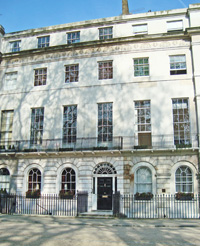
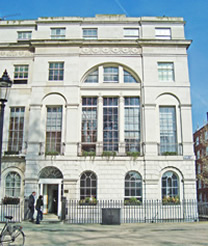
No. 2 Fitzroy Square (left) and No. 1 Fitzroy Square (right).

Nos. 1 and 2 are situated on the east side of Fitzroy Square
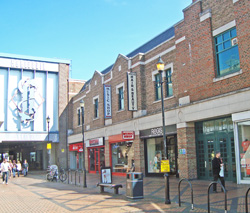
The approximate site of the temporary
war-time Out-Patients Department at No. 31 Queen's Road in Watford is
now occupied by Hooters Music Shop.
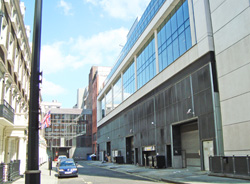
The southern side of Granville Place has been redeveloped and Nos. 14-16 replaced by a modern block.

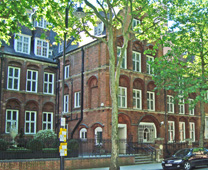
Nos. 4-5 Collingham Gardens.
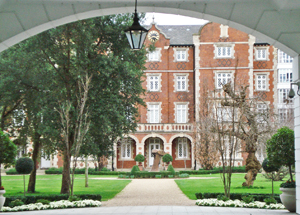
St Mary Abbot's Hospital, final resting place of the Metropolitan Ear Nose and Throat Hospital.
References (Accessed 23rd December 2015)
(Author unstated) 1892 Throat and ear practice in Great Britain. Journal of Laryngology, Rhinology, and Otology 6, 447-453.
(Author unstated) 1938 James Yearsley and the Metropolitan Ear Nose and Throat Hospital, 1838-1938. British Medical Journal 1, 464.
Black N 2006 Walking London's Medical History. London, Royal Society of Medicine Press.
http://the-mastiff-by-marcel-wynants.com
www.aim25.ac.uk
www.architecture.com (1)
www.architecture.com (2)